Vladimir Karpukhin
CM3: A Causal Masked Multimodal Model of the Internet
Jan 19, 2022

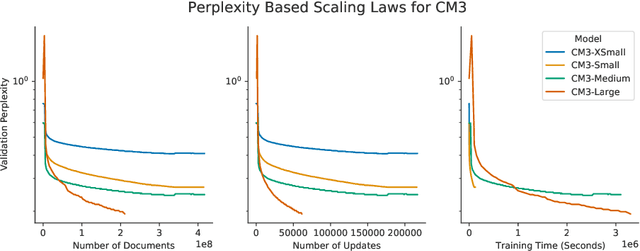
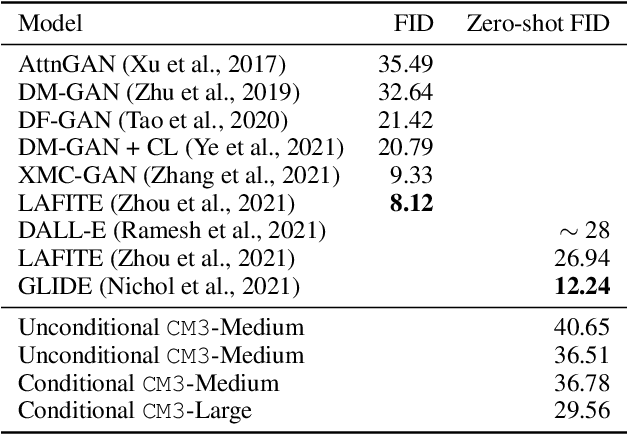
Abstract:We introduce CM3, a family of causally masked generative models trained over a large corpus of structured multi-modal documents that can contain both text and image tokens. Our new causally masked approach generates tokens left to right while also masking out a small number of long token spans that are generated at the end of the string, instead of their original positions. The casual masking object provides a type of hybrid of the more common causal and masked language models, by enabling full generative modeling while also providing bidirectional context when generating the masked spans. We train causally masked language-image models on large-scale web and Wikipedia articles, where each document contains all of the text, hypertext markup, hyperlinks, and image tokens (from a VQVAE-GAN), provided in the order they appear in the original HTML source (before masking). The resulting CM3 models can generate rich structured, multi-modal outputs while conditioning on arbitrary masked document contexts, and thereby implicitly learn a wide range of text, image, and cross modal tasks. They can be prompted to recover, in a zero-shot fashion, the functionality of models such as DALL-E, GENRE, and HTLM. We set the new state-of-the-art in zero-shot summarization, entity linking, and entity disambiguation while maintaining competitive performance in the fine-tuning setting. We can generate images unconditionally, conditioned on text (like DALL-E) and do captioning all in a zero-shot setting with a single model.
The Web Is Your Oyster -- Knowledge-Intensive NLP against a Very Large Web Corpus
Dec 18, 2021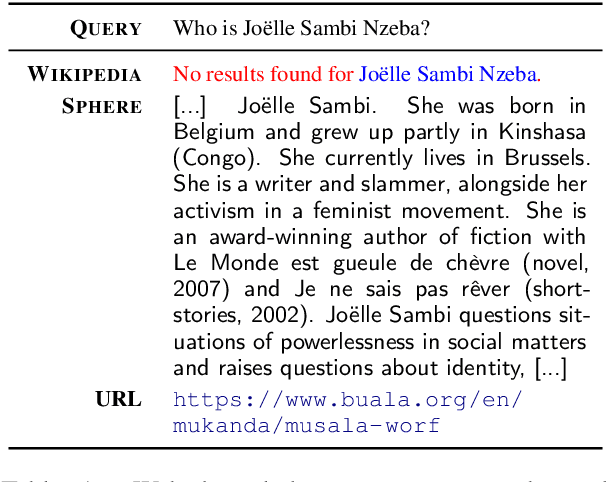
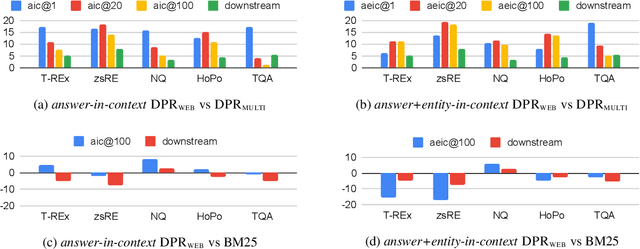


Abstract:In order to address the increasing demands of real-world applications, the research for knowledge-intensive NLP (KI-NLP) should advance by capturing the challenges of a truly open-domain environment: web scale knowledge, lack of structure, inconsistent quality, and noise. To this end, we propose a new setup for evaluating existing KI-NLP tasks in which we generalize the background corpus to a universal web snapshot. We repurpose KILT, a standard KI-NLP benchmark initially developed for Wikipedia, and ask systems to use a subset of CCNet - the Sphere corpus - as a knowledge source. In contrast to Wikipedia, Sphere is orders of magnitude larger and better reflects the full diversity of knowledge on the Internet. We find that despite potential gaps of coverage, challenges of scale, lack of structure and lower quality, retrieval from Sphere enables a state-of-the-art retrieve-and-read system to match and even outperform Wikipedia-based models on several KILT tasks - even if we aggressively filter content that looks like Wikipedia. We also observe that while a single dense passage index over Wikipedia can outperform a sparse BM25 version, on Sphere this is not yet possible. To facilitate further research into this area, and minimise the community's reliance on proprietary black box search engines, we will share our indices, evaluation metrics and infrastructure.
Discourse-Aware Prompt Design for Text Generation
Dec 10, 2021



Abstract:Current efficient fine-tuning methods (e.g., adapters, prefix-tuning, etc.) have optimized conditional text generation via training a small set of extra parameters of the neural language model, while freezing the rest for efficiency. While showing strong performance on some generation tasks, they don't generalize across all generation tasks. In this work, we show that prompt based conditional text generation can be improved with simple and efficient methods that simulate modeling the discourse structure of human written text. We introduce two key design choices: First we show that a higher-level discourse structure of human written text can be modelled with \textit{hierarchical blocking} on prefix parameters that enable spanning different parts of the input and output text and yield more coherent output generations. Second, we propose sparse prefix tuning by introducing \textit{attention sparsity} on the prefix parameters at different layers of the network and learn sparse transformations on the softmax-function, respectively. We find that sparse attention enables the prefix-tuning to better control of the input contents (salient facts) yielding more efficient tuning of the prefix-parameters. Experiments on a wide-variety of text generation tasks show that structured design of prefix parameters can achieve comparable results to fine-tuning all parameters while outperforming standard prefix-tuning on all generation tasks even in low-resource settings.
Domain-matched Pre-training Tasks for Dense Retrieval
Jul 28, 2021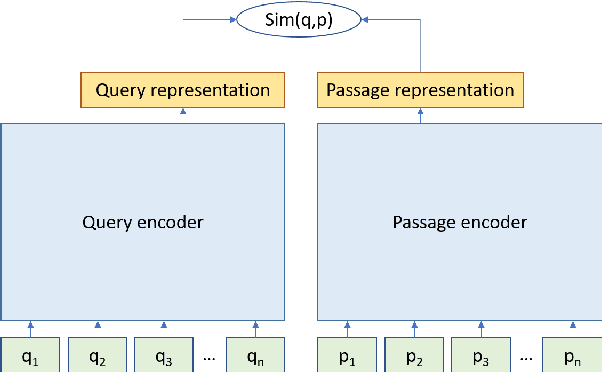
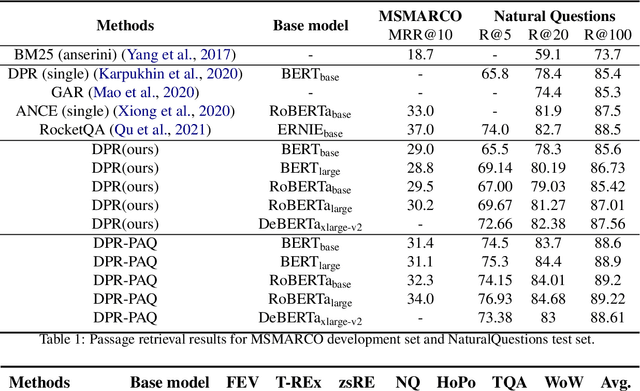

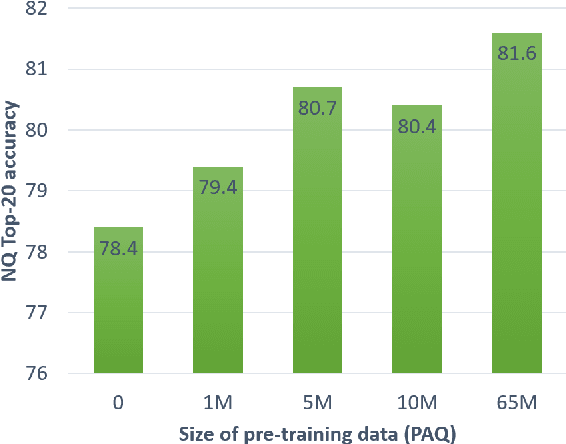
Abstract:Pre-training on larger datasets with ever increasing model size is now a proven recipe for increased performance across almost all NLP tasks. A notable exception is information retrieval, where additional pre-training has so far failed to produce convincing results. We show that, with the right pre-training setup, this barrier can be overcome. We demonstrate this by pre-training large bi-encoder models on 1) a recently released set of 65 million synthetically generated questions, and 2) 200 million post-comment pairs from a preexisting dataset of Reddit conversations made available by pushshift.io. We evaluate on a set of information retrieval and dialogue retrieval benchmarks, showing substantial improvements over supervised baselines.
NeurIPS 2020 EfficientQA Competition: Systems, Analyses and Lessons Learned
Jan 01, 2021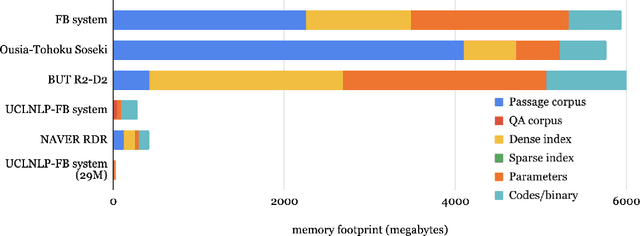
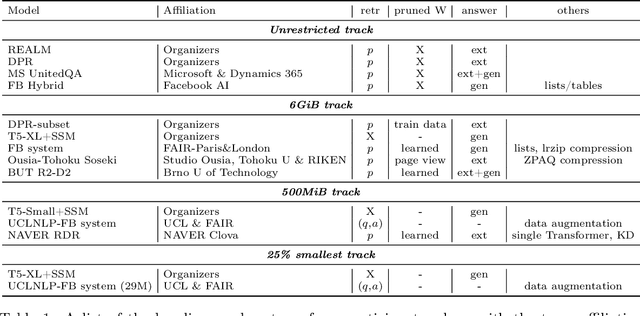
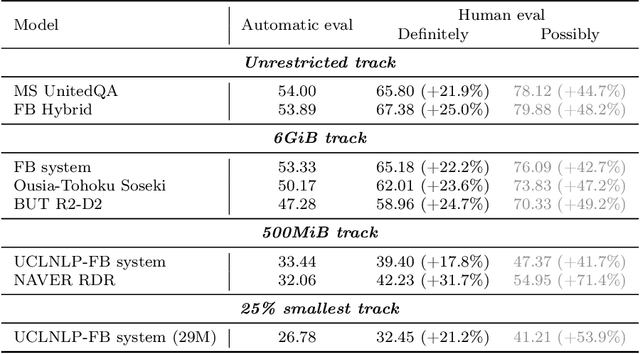
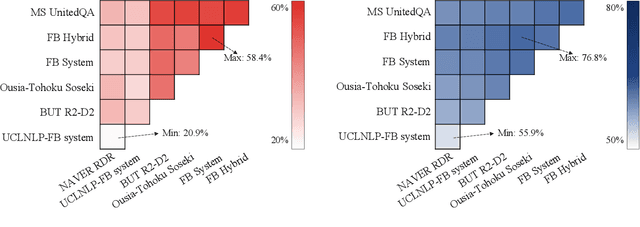
Abstract:We review the EfficientQA competition from NeurIPS 2020. The competition focused on open-domain question answering (QA), where systems take natural language questions as input and return natural language answers. The aim of the competition was to build systems that can predict correct answers while also satisfying strict on-disk memory budgets. These memory budgets were designed to encourage contestants to explore the trade-off between storing large, redundant, retrieval corpora or the parameters of large learned models. In this report, we describe the motivation and organization of the competition, review the best submissions, and analyze system predictions to inform a discussion of evaluation for open-domain QA.
Multi-task Retrieval for Knowledge-Intensive Tasks
Jan 01, 2021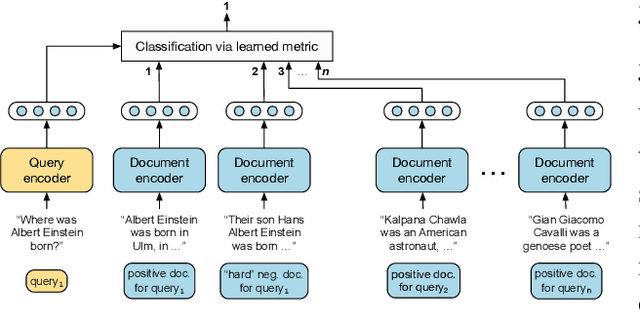
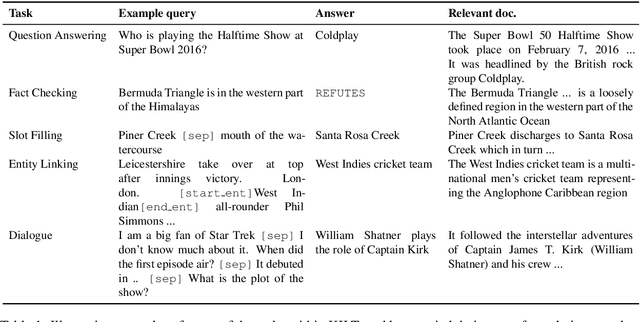
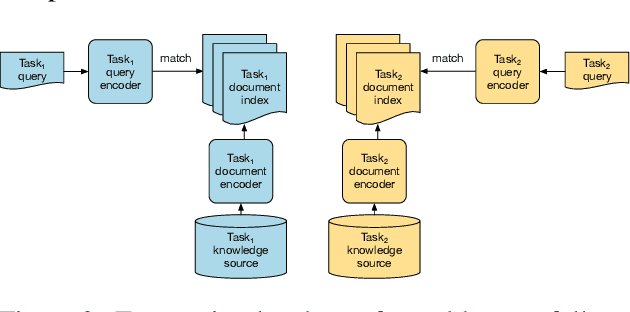
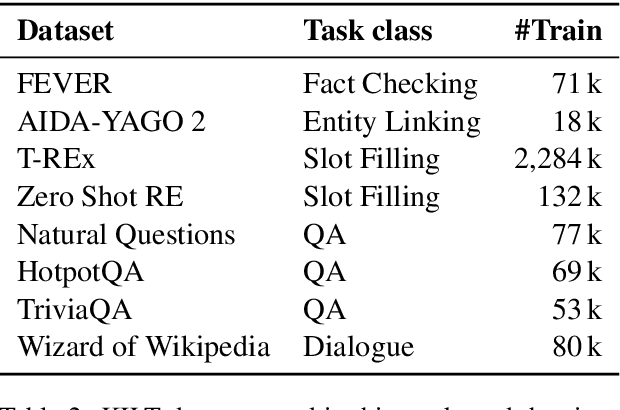
Abstract:Retrieving relevant contexts from a large corpus is a crucial step for tasks such as open-domain question answering and fact checking. Although neural retrieval outperforms traditional methods like tf-idf and BM25, its performance degrades considerably when applied to out-of-domain data. Driven by the question of whether a neural retrieval model can be universal and perform robustly on a wide variety of problems, we propose a multi-task trained model. Our approach not only outperforms previous methods in the few-shot setting, but also rivals specialised neural retrievers, even when in-domain training data is abundant. With the help of our retriever, we improve existing models for downstream tasks and closely match or improve the state of the art on multiple benchmarks.
Joint Verification and Reranking for Open Fact Checking Over Tables
Dec 30, 2020



Abstract:Structured information is an important knowledge source for automatic verification of factual claims. Nevertheless, the majority of existing research into this task has focused on textual data, and the few recent inquiries into structured data have been for the closed-domain setting where appropriate evidence for each claim is assumed to have already been retrieved. In this paper, we investigate verification over structured data in the open-domain setting, introducing a joint reranking-and-verification model which fuses evidence documents in the verification component. Our open-domain model achieves performance comparable to the closed-domain state-of-the-art on the TabFact dataset, and demonstrates performance gains from the inclusion of multiple tables as well as a significant improvement over a heuristic retrieval baseline.
Unified Open-Domain Question Answering with Structured and Unstructured Knowledge
Dec 29, 2020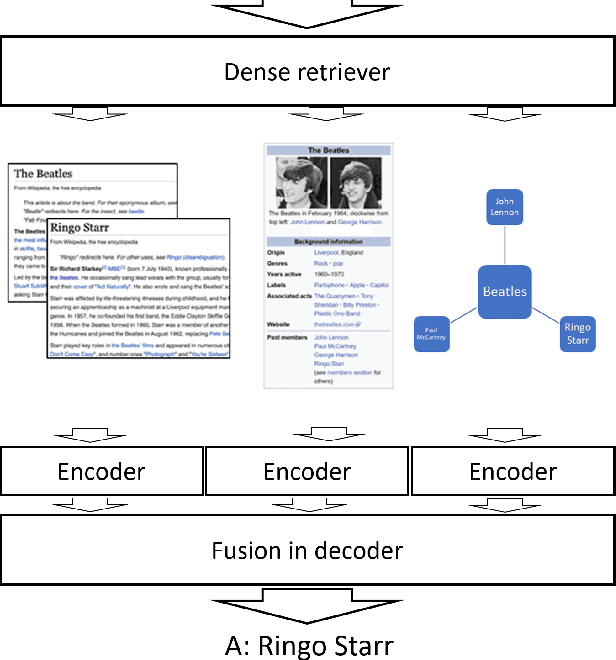
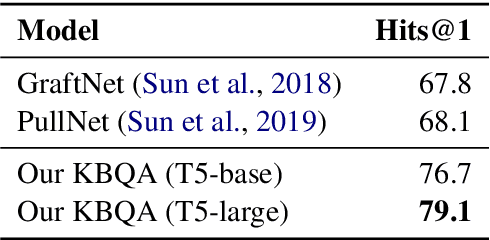
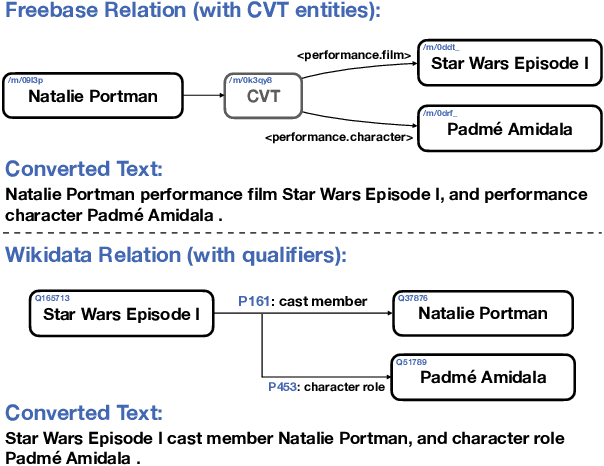
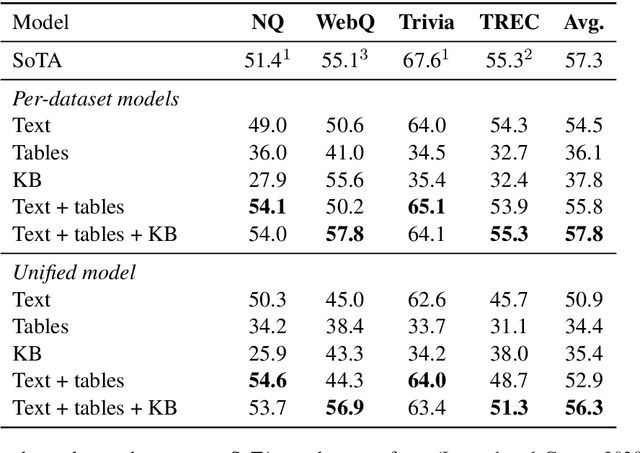
Abstract:We study open-domain question answering (ODQA) with structured, unstructured and semi-structured knowledge sources, including text, tables, lists, and knowledge bases. Our approach homogenizes all sources by reducing them to text, and applies recent, powerful retriever-reader models which have so far been limited to text sources only. We show that knowledge-base QA can be greatly improved when reformulated in this way. Contrary to previous work, we find that combining sources always helps, even for datasets which target a single source by construction. As a result, our unified model produces state-of-the-art results on 3 popular ODQA benchmarks.
Retrieval-Augmented Generation for Knowledge-Intensive NLP Tasks
May 22, 2020



Abstract:Large pre-trained language models have been shown to store factual knowledge in their parameters, and achieve state-of-the-art results when fine-tuned on downstream NLP tasks. However, their ability to access and precisely manipulate knowledge is still limited, and hence on knowledge-intensive tasks, their performance lags behind task-specific architectures. Additionally, providing provenance for their decisions and updating their world knowledge remain open research problems. Pre-trained models with a differentiable access mechanism to explicit non-parametric memory can overcome this issue, but have so far been only investigated for extractive downstream tasks. We explore a general-purpose fine-tuning recipe for retrieval-augmented generation (RAG) -- models which combine pre-trained parametric and non-parametric memory for language generation. We introduce RAG models where the parametric memory is a pre-trained seq2seq model and the non-parametric memory is a dense vector index of Wikipedia, accessed with a pre-trained neural retriever. We compare two RAG formulations, one which conditions on the same retrieved passages across the whole generated sequence, the other can use different passages per token. We fine-tune and evaluate our models on a wide range of knowledge-intensive NLP tasks and set the state-of-the-art on three open domain QA tasks, outperforming parametric seq2seq models and task-specific retrieve-and-extract architectures. For language generation tasks, we find that RAG models generate more specific, diverse and factual language than a state-of-the-art parametric-only seq2seq baseline.
Dense Passage Retrieval for Open-Domain Question Answering
May 02, 2020



Abstract:Open-domain question answering relies on efficient passage retrieval to select candidate contexts, where traditional sparse vector space models, such as TF-IDF or BM25, are the de facto method. In this work, we show that retrieval can be practically implemented using dense representations alone, where embeddings are learned from a small number of questions and passages by a simple dual-encoder framework. When evaluated on a wide range of open-domain QA datasets, our dense retriever outperforms a strong Lucene-BM25 system largely by 9%-19% absolute in terms of top-20 passage retrieval accuracy, and helps our end-to-end QA system establish new state-of-the-art on multiple open-domain QA benchmarks.
 Add to Chrome
Add to Chrome Add to Firefox
Add to Firefox Add to Edge
Add to Edge